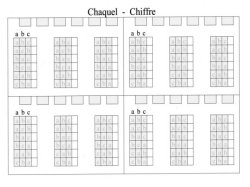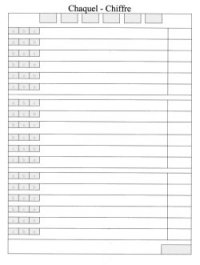
Form 1
Form 2
|
|
|||||
|
This is a version of a well known game we often use to amuse ourselves and keep the grey matter active. We use an old pack of cards, including two jokers, and either scrap paper or we use printouts of one of the forms given below. If you wish you can download a word file that will print either of the pages shown at the side. Arranging the cards: Divide to pack into the following piles: Pile 1 known as the "Large Ordinals" contains eight cards - are all the red court cards plus the two jokers (No jokers - use two black court cards as these are not needed for anything else). Pile 2 known as the "Middle Ordinals" contains ten cards - are all the black cards from and including 6 to 10. Pile 3 known as the "Little Ordinals" contains ten cards - are all the red cards from and including 5 down to Ace. Pile 4 known as the "Target Numbers" contains twenty cards and is the rest of the cards from Ace to 10. Card Values: Large ordinals - Jack/Knave = 25, Queen = 50, King = 75 and Joker = 100. Middle and Little ordinals are their spot count, Ace = 1. Target numbers are their spot count except 10 which is 0 (zero). The suits have no value, other than separating into black and red makes it easier to spot cards that have been returned to the wrong pile. The play: There are many ways of playing this game, some if which are given below, and it can be played either on your own or with other people. If you just wish to exercise the brain, then select the ordinals as given below , then select the targets and simply work your way through the combinations - use scap paper or the first form for this. For the competition version use the second form and you will also need a method for timing. In this case the distribution of the ordinals is decided but they are not displayed until after the three sets of targets are displayed and recorded. After the ordinals are displayed, the countdown time should begin. Getting the numbers: The ordinals - First a player selects, without looking at any of the cards, a total six cards from the Large, Middle and Little ordinal piles, taking at least one from each pile. We normally call out how many we want from each, e.g. 1, 3, 2. (Player's note - as a general rule we find a maximum of 2 large numbers is sufficient.) These cards are displayed in decending order of value to give six integer values, e.g. 75, 10, 7, 6, 4, 2. We enter these values into the six boxes at the top of one of the play frames (there are four on the first form or just the one on the second form). The targets - the top three cards of the Target number pile are turned over to give the basis for six combinations of a three digit number. ABC, ACB, BAC, BCA, CAB & CBA. For example 2, 7, 4 gives 274, 247, 724, 742, 427 and 472. If a 10 is turned over then the leading zero is treated as a blank - for example the cards 2, 10, 4 would give: 204, 240, 24, 42, 420 and 402 If two cards of the same value are turned over - say 2, 7, 7 which generate the sequence 277, 277, 727 772 727 772, we convert it to 277, 77, 727 772, 27, 72 by modifying the duplicate numbers to give two digit number by making the first digit a zero, hence the second number is not a repeat of 277 but becomes 77, similarly with the third and fifth combinations. You then repeat the selection and calculation of the target numbers for a further to sets. Ok. So now you have 6 ordinal numbers and eighteen target numbers. The mental bit: You now have to use the any or all of the ordinal numbers to calculate each of the target numbers. You can only use a ordinal number once for each target number. All divisions must generate an integer result e.g. 12 / 3 = 4 is Ok, but 12 / 5 is not. For example (I have only shown one set of targets to save space): Ordinals: [ 75 ], [ 10 ], [ 7 ], [ 6 ], [ 4 ], [ 2 ] Target 274 - Calculation: 75 * 4 - 10 * 2 - 6 Target 247 - Calculation: 6 * 4 * 10 + 7 Target 427 - Calculation: (6 * 75) - (10 + 7 + 4 + 2) Target 472 - Calculation: ((75 + 4) * 6) - 2 Target 724 - Calculation: ((75 - 6 / 2) * 10) + 4 Target 742 - Calculation: 75 * 10 - 6 - 2 As you will note there are other ways of getting to the same target number, but you only have to find one. Sometimes it is not possible to get to the target - if in competition, get as close as possible. Scoring: If you are doing the competition version and scoring, allow thirty minutes (reduce this to twenty five, twenty or fifteen minutes if everyone is always getting full marks) from the time the oridinal cards are turned over. The method of calculation is written in the box beside each target number. You can use any agreed form of notation, we use * multiply, / divide, + add, - deduct and in that sequence, i.e. multiply or divide before add or subtract and use braces ( do this first ) to denote change of sequence. For example, parsing each expression from left to right, calculate the contents of the braces first, working from the inner most to the outer ones, do each multiply or divide, then each addition or subtraction: The expression: 2 * 3 + 12 / 6 - 3 = 6 + 2 - 3 = 5 The expression: 2 * (3 + 12) / 6 - 3 = 2 * 15 / 6 - 3 = 5 - 3 = 2 The expression: 2 * 3 + 12 / (6 - 3) = 2 * 3 + 12 / 3 = 6 + 4 = 10 The expression: (2 * 3 + 12) / (6 - 3) = (6 + 12) / 3 = 18 / 3 = 6 Similarly the expression 90 - 4 + 3 is the same as 90 - (4 - 3) Give ten points for all correct calculations and deduct one point for each number +/- the target. e.g. 945 instead of 948 = 7 points. Next round: At the end of each round the target number cards are returned to the bottom of the target number pile - we only shuffle at the start of a session, and then not always. At a change of ordinals, we put the exposed cards back at the bottom of their respective piles. Again we do not shuffle very often - its generally better when the cards are in a well mixed sequence to limit the number of double numbers being selected or turned over. Have fun!! Comments are welcome - post@chaquel.com
|
|||||

